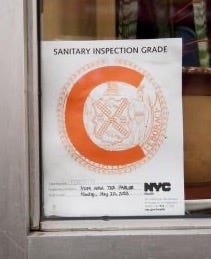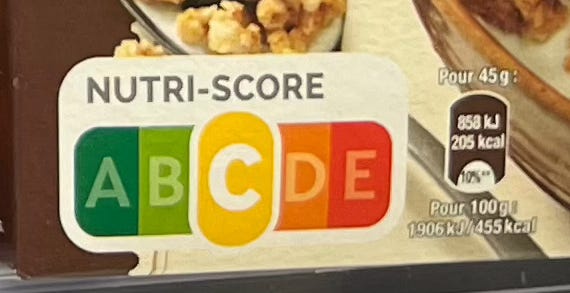Can a cereal box teach us how to depolarize Congress?
Restaurants get sanitization grades. European cereals get Nutri-Score grades. Members of Congress get Bridge Grades. Incentives to get good grades benefit everyone.
Grading members of Congress for how collaboratively they govern is not so different than the Health Department providing sanitation grades for the restaurants where we eat.
People don’t really pay much attention to how the sanitation grading process works. We just want to be confident that when we eat at a restaurant that earns an A we can expect food safety. Dining at a B is taking a calculated risk. But, if you eat at a C and get food poisoning, well that’s on you, buddy.
So, what about this cereal box?
On vacation in France, my family hit the local grocery store for supplies. As I perused the cereal aisle, I noticed a “Nutri-Score” letter grade in the corner of every box.
Did I have any idea how the score is constructed? No.
Did I trust that someone has thought through its scoring system with consumer health in mind? Yes.
Did I assume someone credible has audited such systems? Also, yes.
Did the grade influence my purchase decision? Actually, yes.
How these grades changed my behavior
Initially, I’d been drawn to a bag of Kellogg’s extra, which promoted itself as “riche en fibres”. That’s when I noticed the color-coded score, and was startled to see its D grade. Next, I noticed that the Quaker Cruesli mix of nuts earned an A score, while its counterpart of dark chocolate earned a C. Hmmm. Might it be the chocolate?
Yet, just down the aisle I spotted a box of Nestle’s Chocapic chocolate flakes which earn a solid A Nutri-Score. Oh, hell yeah. My boys had already grabbed a box of Kellogg’s chocolate flakes (grade B) so I grabbed the Nestle counterpart (grade A), and took both home for a taste test.
Three adults did a blind tasting, and two-thirds preferred the grade A over the grade B. To be fair, they were quite similar. As equals, I determined it was a no-brainer to buy the heathier Chocapic (grade A) going forward.
The interesting part: How these grades drive market incentives
In the end, the Nutri-Score tips the balance in my purchase decision. Profit maximizing cereal brands no doubt study their retail numbers closely, and to the extent that even a small group of consumers vote with their wallets and purchase higher graded products, the manufacturers can be expected to respond in kind—adjusting their ingredients and formulations to earn higher grades and capture incremental market share from the market segment who prefer higher Nutri-Score graded products.
Do all consumers care about these grades? Clearly not.
Do at least some consumers make purchases based on these grades? Decidedly yes.
Do market forces create incentive for manufacturers to produce healthier products? Market economists say yes.
Will society overall be better off? Yes—as product health standards improve and as consumers gain freedom of choice with reliable and credible health scores.
The power of incremental nudging of behavior at the margins
Restaurant sanitation grades help diners avoid getting sick. Restaurants have incentive to maintain sanitation to keep their customers.
Nutri-Scores help shoppers choose healthier food options. Manufacturers have incentive to invest in more nutritious food to earn higher profit.
But, what about American politicians? Bridge Grades are like a Nutri-Score or a sanitation grade for members of Congress.
Bridge Grades help voters avoid electing divisive representatives who are unhealthy for our nation. Politicians have incentive to win over non-partisan and independent voters (43% of Americans surveyed).
But, how many voters will care?
The best part of all of this is we only need a fraction of citizens to vote based on political sanitation grades to nudge the game. Politicians are like cereal manufacturers—hard wired to win market share—and some will change their game to improve their grades to the extent it will win them votes and money to support their candidacy. As we vote for and fund these bridgers to get re-elected, their incentive to collaborate gets stronger, and a virtual cycle ensues.
The long game here is to popularize Bridge Grades so that voters can make choices like diners and shoppers when they go to the voting booth. Restaurants are required to post their grades on their walls. Food companies are required to put their Nutri-Score on their packaging.
No such requirement can be expected for political candidates. And, we can’t rely on voters to just blindly trust our Bridge Grades. We’ll have to go out of our way to ensure they are credible, reliable, and trustworthy.
But, to the extent we can build trust in our systems, gain momentum and awareness over time, and find the market segment of voters who care enough to vote for the healthier choices, the incentives will begin to change.
This is how Bridge Grades create a new incentive for members of Congress to collaborate more, and divides us less.
Because if we re-elect members of Congress who earned a C or an F, and we stay stuck in this polarized quagmire, well, that’s on us.
Bridge Grades is a non-ideological report card for politicians. Using 3rd party data, we grade politicians on their abilities to collaborate and build consensus solutions for the common interests of multiple parties versus how polarizing they behave. In aggregating data from multiple non-partisan 3rd party sources, Bridge Grade is like Rotten Tomatoes for politicians. Bridge Grades measure not “what” a politician thinks, but rather “how” the politician behaves. Independent of red or blue ideology, Bridge Grades objectively sorts bridgers from dividers. Updated Bridge Grades for the 119th Congress coming in Summer 2025.






Awesome analogy. And there might be even more there to learn from:
- NutriScore seems to be voluntary, but widely adopted in some EU countries / by some companies
- Even on voluntary basis, looks like it works as a incentive to improve products: your picture of Kellogg's packaging shows large extra call out saying it is now "Now NutriScore B - and still as good" (quick check of the website: Kellogg reduced sugar and increased cocoa content)
- The system is not w/o controversy, it's challenging and important to get the methodology right: https://www.hooleybrown.com/blog-post/whats-the-problem-with-nutri-score
Fantastic analogy, Brad! Thanks for sharing.